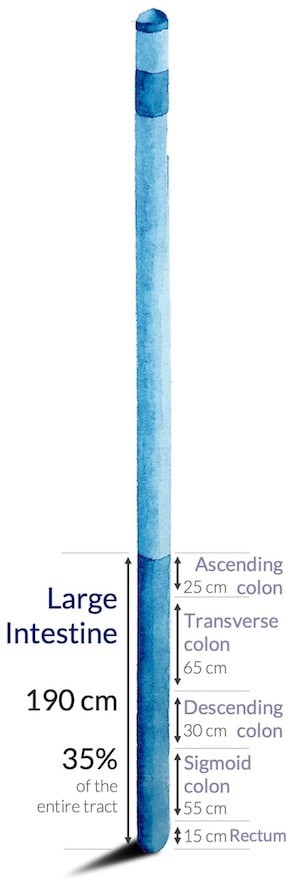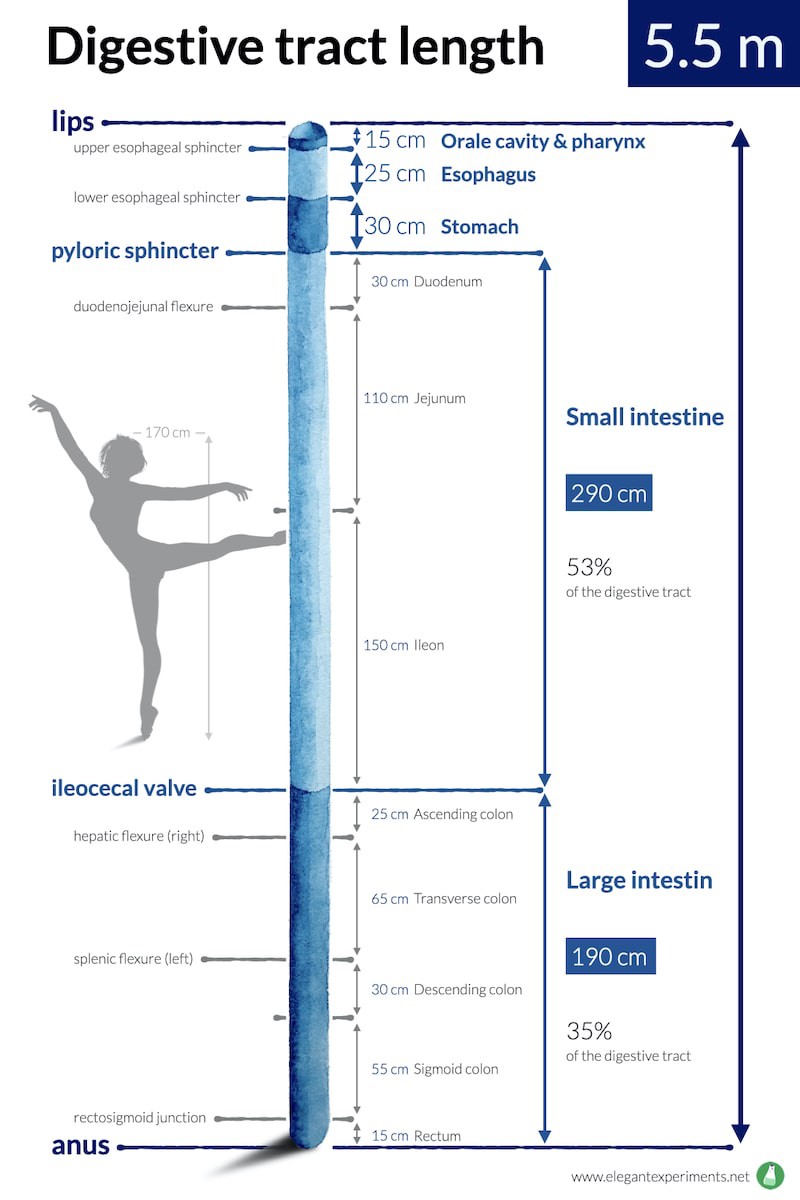How long is the digestive tract? A visual synthesis

This post is part of my project about the Digestive System.
What is the length of the entire human digestive system? What is the length of the intestine?
From lips to anus, our digestive tract is about 5.5 meters long (18 feet). That is, your own digestive tract is about 3 times your height! And more than half of this corresponds to the small intestine!
Estimating the actual length of the gastrointestinal tract is difficult because it is basically a tube of muscles that does not have a fixed shape. That said, many researchers have tried to estimate our gut length over the years. Here I reviewed and selected robust and recent works and summarized them into a visual synthesis.
For an overview, you can go directly to the Synthetic Diagram.
To access the raw data, including ranges and references, you can go to the supplemental data section. If you like to know how I did this review, you can have a look at the method section.
Have a good reading!
Table of content
Entire digestive tract: 5.5 m long (18 feet)
From lips to anus, our gastrointestinal tract is a long tube of about 5.5 m (18 feet). That is, your own digestive tract is about 3 times your height!
The inner space within this tube, where the food travels, is called the lumen. The lumen is technically considered out of our body because it is continuous with the external environment1.
5.5 meters long (18 feet) is an average, though, and considered valid for a “standard man of 70 kg”.
Note that some recent textbooks still mention higher values, as much as more than 6 m long (20 feet) for the small intestine alone2! Yet, these values correspond to former estimates that are less accurate3.
From the lips to the lower end of the stomach: 0.7 m (28 in)
From the lips to the lower end of the stomach, there is about 70 cm (28 in).
The oral cavity is approximately 10 cm long (4 in) and is followed by the pharynx of about 5 cm long (2 in).
The esophagus length averages around 25 cm (10 in), depending on the height of individuals. It moves the foodstuff, called the bolus, from the mouth to the stomach.
The stomach measures about 30 cm long (12 in), with a long side and a short side, due to its curved shape. The stomach mixes the bolus with gastric juice, creating a mixture called chyme.
Small intestine length: 2.9 m (9 feet)
The length of the small intestine is about 290 cm (9 feet), that is, about 1/2 of the entire length of the digestive tract3!
The small intestine consists of 3 parts:
- The duodenum length is 30 cm (12 in),
- the jejunum length is 110 cm (43 in), and
- the ileum length is 150 cm (60 in).
The duodenum mixes the acidic chyme, coming from the stomach, with the alkaline bile liberated by the gallbladder and the pancreatic juice arriving from the pancreas.
The chyme travels then through the jejunum and through the ileum.
Large intestine length: 1.9 m (6 feet)
The length of the large intestine is about 190 cm (6 feet), that is, about 1/3 of the entire length of the digestive tract3.
The large intestine consists of 5 main parts:
- The ascending colon length is 25 cm (10 in),
- the transverse colon length is 65 cm (26 in),
- the descending colon length is 30 cm (12 in),
- the sigmoid colon length is 55 cm (22 in), and
- the rectum length is 15 cm (6 in).
At the beginning of the ascending colon is the cecum. It is the part into which the jejunum spills the chyme and where the appendix is connected. The appendix is a narrow extension of the large intestine, which measures about 10 cm long (4 in).
The ascending colon, the transverse colon, the descending colon, and the sigmoid colon are anatomically distinguished by flexures, that is, places where the intestine folds and changes direction.
The sigmoid colon leads to the rectum. The rectum finishes by the anal canal, which measures about 3 cm long (1 in).
Method
In order to do this visual synthesis, I reviewed some quality textbooks and scientific publications reporting values of the length of the different sections of the human gastrointestinal tract.
Estimating the length of the digestive tract is difficult because it is basically a tube of muscles that does not have a fixed shape. The shape and length of the intestine, in particular, is constantly changing. Authors report that intestine length is thought to vary according to a diurnal cycle, but also to depend on diet, diseases, age, sex, etc3.
Besides this natural variability between individuals, there is also a high uncertainty in measurements. This is due to the difficulty of accessing these organs, hidden in our bodies. For instance, measurements of the small intestine during a surgical operation, such as a laparotomy , show a higher length than other techniques not involving the manipulation of the gut. Measurements of the large intestine after death tend to be higher than in vivo measurements. Other techniques more accurate include intubation, and especially radiography which does not disturb mechanically the organs3.
, show a higher length than other techniques not involving the manipulation of the gut. Measurements of the large intestine after death tend to be higher than in vivo measurements. Other techniques more accurate include intubation, and especially radiography which does not disturb mechanically the organs3.
Among all the sections of the digestive tract, the small and large intestine have the largest ranges of measured values. For these two sections, I followed the same approach as Helander and Fändriks (2014)3, by favoring measurements on healthy individuals, from intubation and radiography over laparotomy and autopsy.
As my objective here is mainly educational, I tried to find a balance between accuracy and clarity. I hence extracted average values for each section of the digestive system, instead of ranges, and I rounded these averages to obtain a clear message with easy to remember numbers.
These measurements should be relevant for a “standard healthy adult man of 70 kg”.
If you like to access the raw data, including ranges and references, see the following section.
Supplemental data
Length of the different sections of the digestive tract in adults, in centimeters.
| Section | Average length (cm) | References |
|---|---|---|
| Oral cavity | 10 | 4 |
| Pharynx | 5 | 4 |
| Esophagus | 25 | 2–5 |
| Stomach | 30 | 6 |
| Small intestine | 290 | 1,3,5 |
| — Duodenum | 30 | 1–5 |
| — Jejunum | 110 | 1,2 |
| — Ileum | 150 | 1,2 |
| Large intestine | 190 | 1,3,5,7 |
| — Ascending colon | 25 | 3,7 |
| —— Cecum | ||
| —— Appendix | 10 | 2,5,7 |
| — Transverse colon | 65 | 3,7 |
| — Descending colon | 30 | 3,7 |
| — Sigmoid colon | 55 | 3,7 |
| — Rectum | 15 | 3,7 |
| —— Anal canal | 3 | 2,5,7 |
CSV file. Includes complete references with page numbers, along with Min-Max ranges and detailed explanations of the calculation method.
Did you enjoy this post?
Great! Then, you may also like to see what’s the surface area of the digestive tract.
References
Open license
The text, images, and supplemental data are under an open license, meaning that you are free to share adaptations, even for commercial purposes! As long as you give credit to my work by mentioning “Elegant Experiments” with a link to www.elegantexperiments.net
Will you make something out of this work? We would be very interested to see the result!





